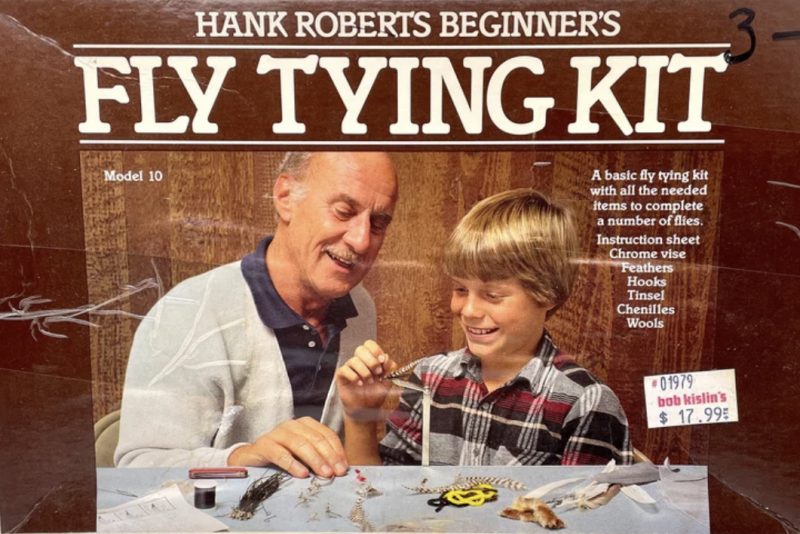Production Mode: Greg Blessing’s Tying Space
When you talk with Greg Blessing about his space for tying flies, the conversation doesn’t stray into abstract ideas about a spiritual escape. You don’t hear words like “Zen” or “art” or “my craft.” Not one mention of the meditative qualities of fly tying. Now, I don’t doubt that Greg may feel those things when tying. But what you hear from Greg is that his tying space is for production.
An Evolution

It was Christmas 1966 when Greg Blessing received his Hank Roberts Beginner’s Fly Tying Kit as a gift. Greg’s history with fly tying spans some 56+ years. A lot can happen in that time.
One thing you hear in Greg’s voice and in the stories he shares is a sense of history about the shop and of fly tying. One of his first mentors was Kent Brekke, the original owner of Angler’s Covey. Greg would help Kent package materials for fly tying.
“We didn’t have the synthetics we have today. For ‘antron,’ we stripped materials from old, grey phone cables about 3/8” in diameter.”
They did have natural materials. In fact, some of the feathers they used were from Kent’s other passion – bird hunting. But mostly, they had to be innovative in what they used to tie flies and what materials they made available to customers.
Today, with the vast amount of natural and artificial materials available, fly tyers have quite an advantage.
Change the Learning Curve
Greg points to his Hank Roberts tying kit as the introduction to tying and launching a period when he was a “self taught” tyer, yet he also hints at the idea of mentorship while we talked over breakfast. Of course, there was Kent Brekke who was an early mentor. But Greg passed on some techniques to A. K. Best in 1993 during a class at Angler’s Covey. Sharing ideas with others is a theme that surfaces.
I had the sense while listening to Greg that there is a certain ebb and flow when learning to tie. There are times of being alone at the vise, for sure, but there are also times for interacting with others as you learn. Resources like YouTube videos and books have their place — but they also don’t cut it. You need that hands-on experience with a mentor beside you offering feedback as you tie.
“The tying classes available now are also an advantage for new tyers,” Greg adds. “They can learn in one year what it took me 15 years to learn. And they should go to the Open Tie Nights so you can watch and learn from others.”
His Tying Space

At the heart of a tying space is the number one tool for efficient tying. Greg encourages new tyers to invest in a good vise.
“My first vise was from a Sunrise Kit. And the most frustrating thing was getting it to hold the hook correctly. You’re always heavy handed when you start, and I would pull the hook out of there all the time. I finally upgraded to something beyond a $5.00 vise.”
As Greg got more immersed in tying, he knew he needed a more dedicated place. When Cindi and Greg bought their house, it was just about 750 square feet. Greg needed some more room, so he converted their porch into an office and tying space. “Laid the foundation, put up walls, and roofed it in. Now it’s my tying space. I can have everything in there. Nobody can mess with it.”
For storing and organizing his materials, Greg retreived cabinets from the old Victorian where the Covey began. And it looks like the organizing principle for Greg is along the lines of “It works for me. I can find what I need when I need it.”
Production Mode
Greg may not necessarily describe his tying space as some sort of spiritual retreat or a place to get all Zen about it. Listening to him, I get a sense that his tying space completely defines the idea of a “workspace.” His tying space is a place for production. And his history of tying, especially as he began and progressed through a life of guiding, is testament to productivity.
“Most of my time was production tying. Tying for a living. Back in the day, I’d tie flies for the Shop.” As a guide, especially as he laid the groundwork for building his career, Greg couldn’t really afford to buy all his flies. “Besides,” he says, “guides who tie their own flies will begin to have more confidence in them. I do it enjoy it, but it has always been more of a necessity.”
Greg adds that, “I’d tie up to 5,000 flies a year for a shop up in Montana. They liked my crippled patterns, like the South Platte BWO cripple.” That relationship also resulted in him getting guided trips from them.
Final Thoughts
You can imagine that a conversation with a guy who has tied flies for over 56 years, fly fished for over 57 years, and has guided for 30+ years that the conversation may take meander more than a river through a high mountain meadow. When Greg and I had breakfast, we planned on talking about his tying space. We talked about so much more — a history, an evolution, and being productive at the vise.
As an aside: one of my favorite flies to use on our tailwaters is Greg’s pattern called the “Purple Haze.” If you don’t have it in your fly box…why not?

Hi Greg,
I enjoyed the article and the “purple haze” tutorial. We moved back to Missouri. I sure miss my frequent fishing in Colorado. You taught me a great deal in our outings. Hope all is well with you.
all the best,
Lothar von Wolfseck